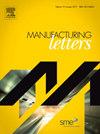Harnessing interpretable and ensemble machine learning techniques for precision fabrication of aligned micro-fibers
IF 1.9
Q3 ENGINEERING, MANUFACTURING
引用次数: 0
Abstract
Electrospinning is a robust technique for producing micro/nano-scale fibrous structures, influenced by intricate interplays of fluid dynamics, aerodynamics, and electromagnetic forces. Depending on the desired outcome, these fibers can adopt various morphologies, including solid, tubular, concentric, and gradient. Such morphologies are modulated by parameters such as collector configuration, flow rate, voltage, solution properties, and nozzle dimensions. However, the task of modeling and predicting these multifaceted morphologies remains complex. Aligned microfibers with 3D orientation hold promise in tissue engineering, regenerative medicine, and drug delivery, necessitating meticulous control over the fabrication parameters. In our research, we tapped into machine learning (ML) to address these challenges. Classification ML models were designed to predict fibrous patterns—aligned, random, or jet branching—based on determinants like voltage, flow rate, and collector configurations. Notably, the Random Forest (RF) and Support Vector Machine (SVM) models, especially with radial kernel-trick, displayed outstanding predictive capabilities on the test data. Furthermore, regression-based ML was harnessed to discern fiber alignment coherency and inter-fiber distances. Models such as Lasso and Ridge regression elucidated predictive coefficients for these characteristics, while ensemble models, like gradient-boosting (GB) decision trees (DT), showcased prowess in regression scenarios. Key findings spotlighted the significance of parameters like plate gap for alignment coherency and needle-to-collector distance for inter-fiber spacing. As we strive to gain granular control over micro/nano feature morphology in electrospinning, understanding predictor-response dynamics is imperative. Our investigation underscores the essential role of ML in enhancing both qualitative and quantitative precision in fabricating advanced fibrous structures. Moreover, fusing ML with real-time process monitoring offers groundbreaking potential, particularly in Bio-Fabrication, regenerative medicine, and tissue engineering, where high-precision manufacturing remains a top priority.
利用可解释和集合机器学习技术精确制造对齐微纤维
电纺丝是生产微米/纳米级纤维结构的强大技术,受到流体动力学、空气动力学和电磁力的复杂相互作用的影响。根据所需的结果,这些纤维可采用各种形态,包括实心、管状、同心和梯度。这些形态受收集器配置、流速、电压、溶液特性和喷嘴尺寸等参数的调节。然而,对这些多层面形态进行建模和预测的任务仍然十分复杂。具有三维取向的对齐微纤维有望用于组织工程、再生医学和药物输送,这就要求对制造参数进行细致的控制。在研究中,我们利用机器学习(ML)来应对这些挑战。我们设计了分类 ML 模型,根据电压、流速和收集器配置等决定因素预测纤维模式--对齐、随机或喷射分支。值得注意的是,随机森林(RF)和支持向量机(SVM)模型,尤其是采用径向核技巧的模型,在测试数据上表现出了出色的预测能力。此外,还利用基于回归的 ML 来辨别纤维排列的一致性和纤维间的距离。拉索和岭回归等模型阐明了这些特征的预测系数,而梯度提升(GB)决策树(DT)等集合模型则在回归场景中展现了卓越的能力。主要研究结果强调了板间隙等参数对配准一致性和针到收集器的距离对纤维间距的重要性。当我们努力在电纺纱中获得对微米/纳米特征形态的颗粒控制时,了解预测器-响应动态是必不可少的。我们的研究强调了 ML 在提高先进纤维结构制造的定性和定量精度方面的重要作用。此外,将 ML 与实时过程监控相结合具有开创性的潜力,特别是在生物制造、再生医学和组织工程领域,高精度制造仍然是重中之重。
本文章由计算机程序翻译,如有差异,请以英文原文为准。
求助全文
约1分钟内获得全文
求助全文
来源期刊

Manufacturing Letters
Engineering-Industrial and Manufacturing Engineering
CiteScore
4.20
自引率
5.10%
发文量
192
审稿时长
60 days
 求助内容:
求助内容: 应助结果提醒方式:
应助结果提醒方式:


